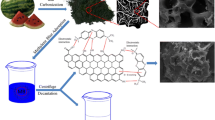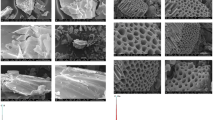Abstract
In this study, the fruit of Catalpa bignonioides was used as the raw material to obtain low-cost activated carbon. The activation process was carried out by using chemical activation method with zinc chloride. Catalpa activated carbon (CAC) was characterized using elemental analyzer, Brunauer-Emmet-Teller (BET), scanning electron microscopy (SEM), Fourier transform infrared spectra (FTIR), and the point of zero charge (pHZPC). The BET surface area of CAC prepared by the impregnation ratio of 30 % ZnCl2 (w/w) was found to be 896.02 m2/g. The efficiency in the process of the removal of methylene blue (MB) from aqueous solution by CAC was searched with different factors, such as temperature, pH, adsorbent concentration, dye concentration, and contact time. From the experimental data obtained, the studies related to adsorption isotherm, kinetics, and thermodynamics were performed. Langmuir model provided the best fit, and the adsorption capacity for the removal of methylene blue from aqueous solution by CAC was calculated to be 271.00 mg/g at 25 °C. The adsorption follows a pseudo-second-order kinetic model. Moreover, the thermodynamic parameters such as ΔG°, ΔH°, and ΔS° presented that the adsorption was spontaneous and endothermic.












Similar content being viewed by others
References
Ahmad, M. A., Ahmad, N., & Bello, O. S. (2014). Adsorptive removal of malachite green dye using durian seed-based activated carbon. Water, Air, and Soil Pollution, 225(2057), 1–18.
Avealr, F. F., Bianchi, M. L., Goncalves, M., & de Mota, E. G. (2010). The use of piassava fibers (Attalea funifever) in the preparation of activated carbon. Biosource Technology, 101, 4639–4645.
Dağdelen, S., Acemioğlu, B., Baran, E., & Koçer, O. (2014). Removal of remozal brilliant blue R from aqueous solution by pirina pretreated with nitric acid and commercial activated carbon. Water, Air, and Soil Pollution, 225(1899), 1–15.
Dutta, S., Bhattacharyya, A., Ganguly, A., Gupta, S., & Basu, S. (2011). Application of response surface methodology for preparation of low-cost adsorbent from citrus fruit peel and for removal of methylene blue. Desalination, 275, 26–36.
Freundlich, H. M. F. (1906). Über die adsorption in lösungen. Zeitschrift für Physikalische Chemie, 57, 385–470.
Geçgel, Ü., & Kolancılar, H. (2011). Adsorption of remazol brilliant blue R on activated carbon prepared from a pine cone. National Production Research, 18, 1–6.
Gupta, S. S., & Bhattacharyya, K. G. (2011). Kinetics of adsorption of metal ions on inorganic materials: a review. Advances in Colloid and Interface Science, 162, 39–58.
Hall, K. R., Eagleton, L. C., Acrivos, A., & Vermeulen, T. (1966). Pore- and solid-diffusion kinetics in fixed-bed adsorption under constant-pattern conditions. Industrial and Engineering Chemistry Fundamentals, 5, 212–223.
Hesas, R. H., Niya, A. A., Daud, W. M. A. W., & Sahu, J. N. (2013). Preparation of granular activated carbon from oil palm shell by microwave-induced chemical activation: optimization using surface response methodology. Chemical Engineering Research and Design, 91, 2447–2456.
Ho, Y. S., & McKay, G. (1999). Pseudo-second order model for sorption processes. Process Biochemistry, 34, 451–465.
Khataee, A. R., Movafeghi, A., Torbati, S., Salehi Lisar, S. Y., & Zarei, M. (2012). Phytoremediation potential of duckweed (Lemna minor L.) in degradation of C. I. acid blue 92: artificial neural network modeling. Ecotoxicology and Environmental Safety, 80(1), 291–298.
Kumar, P. S., Romalingam, K., & Sathishkumar, K. (2011). Removal of methylene blue dye from aqueous solution by activated carbon prepared from cashew nut shell as a new low-cost adsorbents. Korean Journal of Chemical Engineering, 28(1), 149–155.
Lagergren, S. (1898). Zur theorie der sogenannten adsorption gelöster stoffe. Kungliga Svenska Vetenskapsakademiens Handlingar, 24, 1–39.
Langmuir, I. (1916). The constitution and fundamental properties of solids and liquids. Journal of American Chemical Society, 38, 2221–2295.
Li, L., Liu, S., & Zhu, T. (2010). Application of activated carbon derived from scrap tires for adsorption of Rhodamine B. Journal of Environmental Sciences, 22, 1273–1280.
Li, W. H., Yue, Q. Y., Gao, B. Y., Ma, Z. H., Li, Y. J., & Zhao, H. X. (2011). Preparation and utilization of sludge-based activated carbon for the adsorption of dyes from aqueous solutions. Chemical Engineering Journal, 171, 320–327.
Malarvizhi, R., & Ho, Y. S. (2010). The influence of pH and the structure of the dye molecules on adsorption isotherms modeling using activated carbon. Desalination, 264, 97–101.
Martins, A. C., Pezoti, O., Cazetta, A. L., Bedin, K. C., Yamazaki, D. A. S., Bandoch, G. F. G., Asefa, T., Visentainer, J. V., & Almeida, V. C. (2015). Removal of tetracycline by NaOH-activated carbon produced from macadamia nut shells: kinetic and equilibrium studies. Chemical Engineering Journal, 260, 291–299.
Milonjić, S. K., Ruvarac, A. L., & Šušić, M. V. (1975). The heat of immersion of natural magnetite in aqueous solutions. Thermochimica Acta, 11(3), 261–266.
Ozdemir, I., Şahin, M., Orhan, R., & Erdem, M. (2014). Preparation and characterization of activated carbon from grape stalk by zinc chloride activation. Fuel Processing Technology, 125, 200–206.
Ozer, C., Imamoglu, M., Turhan, Y., & Boysan, F. (2012). Removal of methylene blue from aqueous solutions using phosphoric acid activated carbon produced from hazelnut husks. Toxicological & Environmental Chemistry, 94(7), 1283–1293.
Pezoti, O., Jr., Cazetta, A. L., Souza, I. P. A. F., Bedin, K. C., Martins, A. C., Silva, T. L., & Almeida, V. C. (2014). Adsorption studies of methylene blue onto ZnCl2-activated carbon produced from buriti shells (Mauritia flexuosa L.). Journal of Industrial and Engineering Chemistry, 20, 4401–4407.
Robinson, T., McMullan, G., Marchant, R., & Nigam, P. (2001). Remediation of dyes in textile effluent: a critical review on current treatment technologies with a proposed alternative. Bioresource Technology, 77(3), 247–255.
Smith, J. M. (1981). Chemical engineering kinetics. London: Mcgrow-Hill International Book.
Sun, Y., & Webley, P. A. (2010). Preparation of activated carbons from corncob with large specific surface area by a variety of chemical activators and their application in gas storage. Chemical Engineering Journal, 162, 883–892.
Tan, I. A. W., Ahmad, A. L., & Hameed, B. H. (2008). Adsorption of basic dye using activated carbon prepared from oil palm shell: batch and fixed bed studies. Desalination, 225, 13–28.
Vandevivere, P. C., Bianchi, R., & Verstraete, W. (1998). Treatment and reuse of wastewater from the textile wet-processes industry: review of emerging technology. Journal of Chemical Technology and Biotechnology, 72, 289–302.
Weber, C. T., Foletto, E. L., & Meili, L. (2013). Removal of tannery dye from aqueous solution using papaya seed as an efficient natural biosorbent. Water, Air, and Soil Pollution, 224, 1427.
Weng-Hong, L., Qin-Yan, Y., Bao-Yu, G., Zuo-Hao, M., Yan-Jie, L., & Hai-Xia, Z. (2011). Preparation and utilization of sludge-based activated carbon for the adsorption of dyes from aqueous solutions. Chemical Engineering Journal, 171, 320–327.
Yagub, M. T., Sen, T. K., & Ang, H. (2012). Equilibrium, kinetics, and thermodynamics of methylene blue adsorption by pine tree leaves. Water, Air, and Soil Pollution, 223(8), 5267–5282.
Yang, J., & Qiu, K. (2010). Preparation of activated carbon from walnut shell via vacuum chemical activation and their application for methylene blue removal. Chemical Engineering Journal, 165, 209–217.
Yu, L., & Luo, Y.-m. (2014). The adsorption mechanism of anionic and cationic dyes by Jerusalem artichoke stalk-based mesoporous activated carbon. Journal of Environmental Chemical Engineering, 2, 220–229.
Author information
Authors and Affiliations
Corresponding author
Rights and permissions
About this article
Cite this article
Geçgel, Ü., Kocabıyık, B. & Üner, O. Adsorptive Removal of Methylene Blue from Aqueous Solution by the Activated Carbon Obtained from the Fruit of Catalpa bignonioides . Water Air Soil Pollut 226, 238 (2015). https://doi.org/10.1007/s11270-015-2513-4
Received:
Accepted:
Published:
DOI: https://doi.org/10.1007/s11270-015-2513-4




